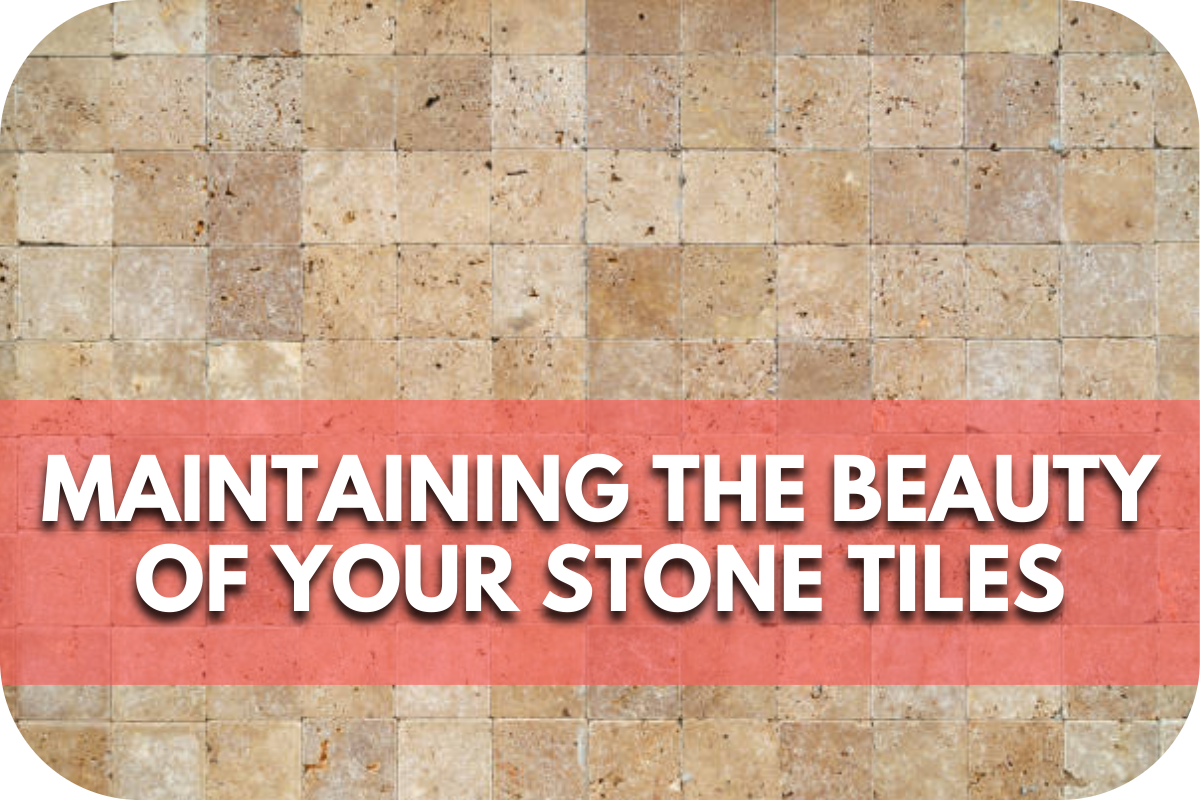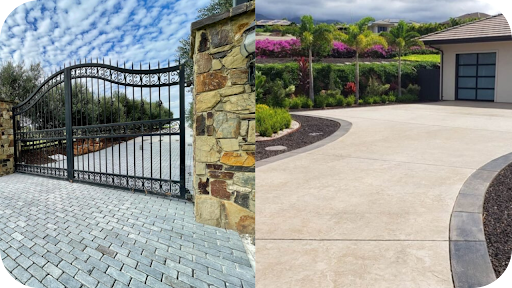
Stone tiles are a stunning addition to any home but can lose their lustre over time if improperly maintained.
Regular care is necessary for your beautiful stone surfaces to become dull, stained, and damaged, diminishing their aesthetic and value.
In this article, we provide expert tips and tricks to maintain the beauty of your stone tiles, ensuring they remain pristine and elegant for years to come.
1. Daily Cleaning Routine
Maintaining the beauty of your stone tiles starts with a consistent daily cleaning routine. Begin by sweeping or vacuuming the tiles to remove dirt and debris, which can scratch the surface if left unattended.
Use a soft-bristled broom or a vacuum cleaner with a brush attachment to avoid damaging the tiles.
Next, prepare a gentle cleaning solution by mixing a few drops of pH-neutral stone cleaner with warm water. Avoid harsh chemicals or acidic cleaners, which can erode the stone’s natural finish.
Dampen a soft, microfibre mop or cloth with the solution and gently wipe the tiles, ensuring even coverage. Use a soft-bristled brush to lightly scrub for tougher spots without applying excessive pressure.
After mopping, rinse the tiles with clean water to remove any residue from the cleaning solution. Dry the tiles thoroughly with a clean cloth to prevent water spots and streaks.
This daily regimen keeps your stone tiles looking their best and extends their lifespan by preventing dirt buildup and surface damage. Consistency is key; a few minutes of care each day will preserve the elegance and integrity of your stone tiles for years to come.
2. Deep Cleaning Techniques
Even with a diligent daily cleaning routine, your stone tiles occasionally require a deep clean to maintain their pristine condition. Start by removing any surface dust and debris with a vacuum cleaner or a soft-bristled broom. This ensures that the deep cleaning process will be more effective and prevents scratching.
Prepare a deep cleaning solution by mixing a pH-neutral stone cleaner with warm water according to the manufacturer’s instructions.
Avoid acidic or abrasive cleaners, which can damage the stone’s surface. Apply the solution using a soft-bristled brush or a non-abrasive scrubbing pad, focusing on grout lines and any stained areas. Gently scrub in a circular motion to lift embedded dirt and grime without harming the tiles.
After scrubbing, rinse the tiles thoroughly with clean water to remove any remaining cleaning solution. It’s crucial to eliminate all residues, which can attract dirt and dull the stone’s finish. Use a wet vacuum to extract excess water, or dry the tiles with a clean cloth.
Consider using a poultice – a paste made from a powdery material and a cleaning agent for stubborn stains. Apply the poultice to the stain, cover it with plastic wrap, and let it sit for 24 to 48 hours. The poultice will draw out the stain, after which you can rinse and dry the area.
3. Sealing Your Stone Tiles
Sealing your stone tiles is essential for preserving natural beauty and enhancing longevity. This process protects against stains, moisture, and daily wear and tear.
Begin by selecting a high-quality, penetrating sealer suitable for your specific type of stone. It’s crucial to choose a sealer that is designed for natural stone to ensure optimal protection.
Before applying the sealer, thoroughly clean the tiles to remove any dirt, dust, or existing stains. Ensure the surface is completely dry, as moisture can affect the sealer’s effectiveness.
Using a clean, soft cloth or a brush, apply the sealer evenly across the stone tiles, following the manufacturer’s instructions. Cover all areas, including grout lines, for comprehensive protection.
Allow the sealer to penetrate the stone for the recommended time, usually 15 to 30 minutes. Wipe away any excess sealer with a clean cloth to avoid a hazy finish. Apply a second coat after the first has dried completely for best results. This ensures maximum protection, especially in high-traffic areas.
Sealing should be done periodically, typically every 1 to 3 years, depending on the stone type and usage. Regular sealing maintains the stone’s resistance to stains and damage, keeping your tiles stunning and pristine for years.
4. Preventing Damage
Preventing damage to your stone tiles is crucial for maintaining their pristine appearance. You can avoid scratches, chips, and cracks with proper care, ensuring your tiles remain beautiful and durable.
Tips for Avoiding Scratches, Chips, and Cracks
Always use soft cleaning tools such as microfibre cloths or soft-bristle brushes to prevent scratches. Avoid dragging heavy or sharp objects across the tiles.
Place doormats at entrances to reduce dirt and grit being tracked onto the surface, as these can cause abrasion over time.
Best Practices for Moving Furniture on Stone Tiles
When moving furniture, lift it rather than dragging it across the floor. Use furniture pads or sliders to minimise contact and protect the tiles from potential damage.
For particularly heavy items, consider using dolly or protective plywood sheets to distribute the weight evenly and prevent pressure points that can cause cracks or chips.
Protective Measures for High-Traffic Areas
High-traffic areas are more prone to wear and tear. To provide extra protection, use area rugs or runners in these spaces. Ensure the rugs have non-slip backings to prevent accidents. Rotate the rugs regularly to distribute wear evenly.
Applying a quality sealant will help shield the tiles from damage and make cleaning easier.
5. Dealing with Specific Issues
Even with regular maintenance, specific issues can arise with stone tiles. Knowing how to address these problems promptly can help preserve their beauty and integrity.
- Removing Mould and Mildew: Mould and mildew can develop in damp areas. To remove them, use a solution of water and mild detergent or a specialised stone-safe mould remover. Apply the solution with a soft brush, scrub gently, and rinse thoroughly with clean water. Ensure the area is well-ventilated and dry to prevent future growth.
- Handling Spills and Stains Promptly: Immediate action is key to preventing stains. Blot spills with a clean, soft cloth—do not rub, as this can spread the stain. For oil-based stains, use a poultice of baking soda and water, leaving it on the stain for 24 hours before rinsing. A mixture of hydrogen peroxide and a few drops of ammonia can be effective for organic stains, such as coffee or wine. Always test any cleaning solution on a small, inconspicuous area first.
- Repairing Minor Damage: Minor chips and cracks can be repaired using a stone repair kit at most hardware stores. Clean the damaged area thoroughly, then apply the repair compound according to the manufacturer’s instructions. Consider professional repair services for deeper cracks to ensure a seamless finish and prevent further damage.
6. Seasonal Maintenance Tips
Adjusting your care routine according to the seasons is crucial for maintaining the beauty and durability of your stone tiles. Here’s how to prepare your tiles for different seasonal challenges.
- Preparing Stone Tiles for Winter: Winter can be particularly harsh on stone tiles, especially in areas with freezing temperatures. To prepare, ensure your tiles are thoroughly sealed to prevent moisture penetration, which can cause cracks when frozen. Clean the tiles to remove dirt and debris, which can scratch the surface. Place doormats at entrances to minimise the amount of salt and grit brought inside, which can be abrasive to the tiles.
- Summer Care Tips: High temperatures and increased foot traffic during summer can affect your stone tiles. Regularly sweep and mop to remove sand and dirt that can scratch the surface. Blinds or curtains can prevent indoor tiles from fading in direct sunlight. Outdoor tiles should be well-sealed to shield them from UV rays and rain damage.
- Addressing Seasonal Challenges Specific to Your Region: Different regions face unique challenges. In humid areas, moisture control is essential to prevent mould and mildew growth; use dehumidifiers and ensure proper ventilation. In regions with heavy rainfall, ensure adequate drainage around outdoor tiles to avoid water pooling and damage. Frequent sweeping and damp mopping for areas with high dust levels will help keep your tiles clean and scratch-free.
Why Should You Use Professional Cleaning and Restoration Services?
Professional cleaning and restoration services offer expertise and experience that can significantly enhance the care of your stone tiles.
Professionals can access specialised equipment and products not typically available to homeowners, ensuring a deeper and more effective clean.
They provide tailored solutions based on thoroughly assessing your tiles and addressing specific issues precisely.
While the upfront cost may seem high, professional services can be cost-effective in the long run by preventing costly repairs and extending the lifespan of your tiles.
Investing in professional care ensures your stone tiles maintain their beauty and durability for years.
Conclusion
By following these expert tips for daily cleaning, sealing, and seasonal care, you can preserve the beauty and durability of your stone tiles.
Implement a regular maintenance routine to ensure long-lasting results.
For professional advice and services, contact Splendour In Stone Melbourne today and let us help you keep your stone tiles in pristine condition.
More To Explore

How to Achieve a Rustic Farmhouse Style with Reclaimed Bricks
Many homeowners want the charm of a rustic farmhouse but struggle to make it feel authentic. Modern materials often look too uniform, leaving spaces without

Comparing Natural Stone and Concrete for Outdoor Projects
Choosing the right surface for your outdoor space is more important than it seems. Pick the wrong material and you could face early wear, fading,


